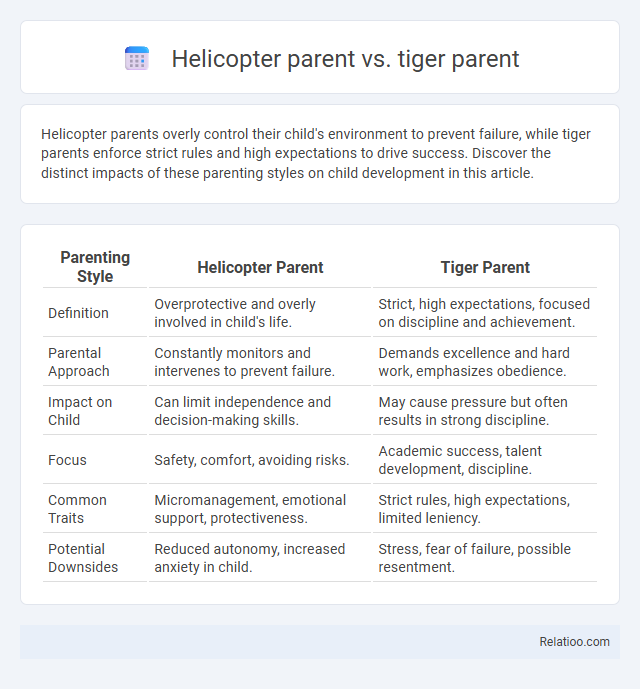Helicopter parents overly control their child's environment to prevent failure, while tiger parents enforce strict rules and high expectations to drive success. Discover the distinct impacts of these parenting styles on child development in this article.
Table of Comparison
| Parenting Style | Helicopter Parent | Tiger Parent |
|---|---|---|
| Definition | Overprotective and overly involved in child's life. | Strict, high expectations, focused on discipline and achievement. |
| Parental Approach | Constantly monitors and intervenes to prevent failure. | Demands excellence and hard work, emphasizes obedience. |
| Impact on Child | Can limit independence and decision-making skills. | May cause pressure but often results in strong discipline. |
| Focus | Safety, comfort, avoiding risks. | Academic success, talent development, discipline. |
| Common Traits | Micromanagement, emotional support, protectiveness. | Strict rules, high expectations, limited leniency. |
| Potential Downsides | Reduced autonomy, increased anxiety in child. | Stress, fear of failure, possible resentment. |
Understanding Helicopter Parenting
Helicopter parenting involves closely monitoring and controlling a child's experiences to prevent failure, often leading to reduced independence. Unlike tiger parents who emphasize strict discipline and high academic achievement, helicopter parents prioritize constant supervision and intervention in everyday activities. Understanding helicopter parenting helps you recognize how excessive involvement can hinder your child's development of resilience and self-confidence.
Defining Tiger Parenting
Tiger parenting emphasizes strict discipline, high academic expectations, and relentless motivation to achieve excellence, often rooted in Asian cultural values. Unlike helicopter parenting, which involves hovering to protect children from failure, tiger parents push their children aggressively toward success, sometimes at the expense of emotional well-being. This authoritarian style contrasts with helicopter parenting's focus on monitoring and intervention, highlighting distinct parental approaches to control and support.
Core Differences Between Helicopter and Tiger Parents
Helicopter parents closely monitor their children's every move, emphasizing safety and involvement in day-to-day activities, while tiger parents enforce strict discipline and high academic expectations rooted in cultural values of achievement. Helicopter parenting stems from a desire to protect and guide through over-involvement, whereas tiger parenting prioritizes obedience and success through rigorous control and structured routines. The core difference lies in helicopter parents' nurturing approach versus tiger parents' authoritative style focused on performance and resilience.
Parenting Styles: Control vs. Achievement
Helicopter parents exhibit high control over their children's daily activities and decisions, seeking to shield them from failure and discomfort, while tiger parents emphasize strict discipline and high achievement, often enforcing rigorous academic and extracurricular demands. Unlike helicopter parents who prioritize constant involvement and monitoring, tiger parents focus on pushing children toward exceptional performance and success. Your choice between these parenting styles impacts your child's autonomy and motivation, balancing control with the pursuit of achievement.
Impact on Children’s Academic Performance
Helicopter parents, Tiger parents, and Snowplow parents each shape children's academic performance differently; helicopter parents closely monitor and intervene in schoolwork, which can lead to elevated stress but higher grades. Tiger parents enforce strict discipline and high expectations, often resulting in improved test scores and academic achievement but also increased pressure and anxiety. Snowplow parents actively remove obstacles from their children's path, which may boost short-term academic success but can hinder development of resilience and problem-solving skills.
Effects on Emotional Well-being
Helicopter parents often contribute to heightened anxiety and diminished self-esteem in children due to overprotection and lack of autonomy. Tiger parents, emphasizing strict discipline and high expectations, can induce stress and fear of failure, potentially leading to emotional distress. In contrast, authoritative parents balance support and independence, fostering resilience and healthy emotional development in their children.
Balancing Discipline and Independence
Helicopter parents exercise intense supervision and control, often limiting their child's independence, while tiger parents enforce strict discipline with high expectations, prioritizing achievement over autonomy. Balancing discipline and independence requires adopting a supportive approach that encourages self-regulation and decision-making, blending firm boundaries with opportunities for autonomy. Effective parenting fosters resilience and responsibility by combining clear rules with encouragement for independent problem-solving and exploration.
Cultural Influences in Parenting Approaches
Helicopter parenting often emerges in Western cultures emphasizing individual achievement and safety, where parents closely monitor children's activities to prevent failure. Tiger parenting is prevalent in East Asian cultures prioritizing discipline, academic excellence, and respect for authority, reflecting Confucian values that stress hard work and family honor. Cultural influences shape these parenting styles by dictating the importance of autonomy versus obedience, impacting child development and parent-child dynamics uniquely in each context.
Long-term Consequences on Child Development
Helicopter parents often hinder children's autonomy and problem-solving skills, leading to increased anxiety and dependence in adulthood. Tiger parents, who emphasize strict discipline and high expectations, can foster academic success but may contribute to suppressed emotional expression and reduced social competence. Both parenting styles risk impairing long-term emotional resilience and self-efficacy, unlike authoritative parenting which balances guidance with independence, promoting healthier child development outcomes.
Choosing the Right Parenting Style
Choosing the right parenting style involves understanding the differences between helicopter, tiger, and authoritative parents to foster a balanced environment for children's growth. Helicopter parents closely monitor and intervene in their children's lives to prevent failure, while tiger parents enforce strict discipline and high expectations to achieve excellence. Authoritative parenting blends responsiveness and structure, promoting independence and resilience, which research shows often leads to the most positive developmental outcomes.

Infographic: Helicopter parent vs Tiger parent
 relatioo.com
relatioo.com